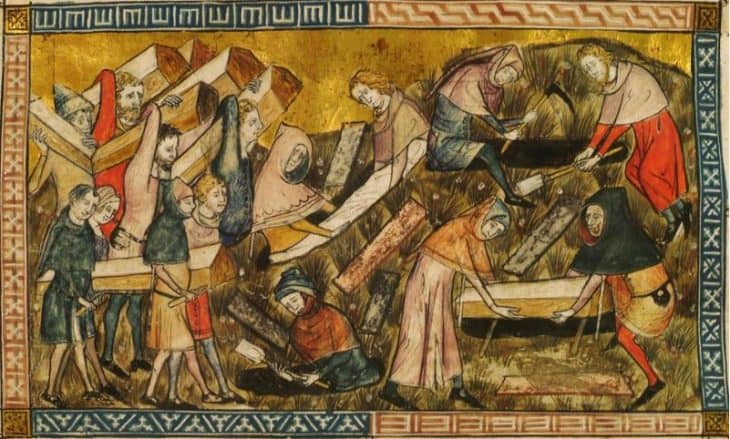
- Name: Black Death, the Great Mortality, the Pestilence
- Number of Deaths: 75 to 200 million people
- Mortality rate: 30% to 50% of infected victims
- Start Place: Central Asia
- Start Time: 1338-1339
- Symptoms: Tumours (buboes or gavocciolos), acute fever, vomiting of blood
- Cause: Yersinia pestis bacterium
- Spread: Fleas on black rats
- Treatment: Insecticides, antibiotics, plague vaccine
- Recurrence: 14th to 17th centuries
- Death Toll: The Black Death Killed 25% to 60% of Europe’s Population
- Epidemic: The Black Death was not the First Plague Epidemic
- Cause: The Population at the Time was Prone to Disease Spread
- Cause: The Black Death was Believed to Be Caused By “Pockets of Bad Air”
- Treatments: Patients Were Often Discouraged from Bathing during the Plague
- Culture: The Black Death Set the Foundation for the Renaissance
- Disease: he Plague Still Exists in the Modern World
- Influence: The Black Death Set Europe Back 150 Years
- Disease: The Plague Virus Now Is Less Fatal than It Used to Be
- Spread: The Plague Took Free Rides on Merchant Ships
- A Village Voluntarily Went into a Shutdown to Stop the Disease Spreading
- Even without Modern Antibiotics, the Plague Was Not a Certain Death Sentence
- Nostradamus Was One of the First Plague Doctors
- The Name Black Death Wasn’t Used at the Time
- Cats and Rats Were Infected but Dogs Were Fine
- William Shakespeare Witnessed the Terrifying Consequences of the Black Death
- A Treatment from the Black Death Era Is Still Popular Today
- The Term Quarantine Was Coined during the Black Death Era
- The Black Death Was Used as Early Germ Warfare
- Dung and Urine were Among Treatments Prescribed by Doctors
Black Death Facts Infographics

The Black Death Killed 25% to 60% of Europe’s Population
The Black Death is the name used to describe the plague epidemic that swept through Europe from 1348 to 1351. One of the most frightening Black Death facts is that it was extremely fatal and spread very quickly.
Although the exact death toll can only be estimated based on what we know now, it is thought between 75 and 200 million people died. It is estimated that 25% to 60% of the European population were wiped out during the epidemic. Some estimations are even set as high as two-thirds of the population.
The Black Death was not the First Plague Epidemic
There are many Black Death facts relating to the devastating consequences that it left behind, but did you know that the Black Death was not actually the first epidemic? It was the second plague epidemic of the Middle Ages.
The first one occurred in the sixth century, and is often referred to as Justinian’s Plague. Just as was the case with the Black Death, the first epidemic was widespread and caused many deaths. However, it did not reach the same frightening magnitude as the Black Death.
The Population at the Time was Prone to Disease Spread
The Black Death was terrifying because of the shocking pace at which it spread. It was not a coincidence that the epidemic swept through Europe as fast as it did. The population at the time very prone to contagious diseases.
The Black Death occurred after a period of rapid population growth in Europe. At that time, there had been two years of harsh winters with torrential rains. The food source was limited, while the population was still growing fast.
This led to a food shortage that drove people and animals from rural areas and into the cities. Crowded living conditions, coupled with a lack of hygiene, allowed diseases to spread extremely quickly.
The Black Death was Believed to Be Caused By ‘Pockets of Bad Air’
It wasn’t until the 1890s that the Y. pestis virus was discovered. When the plague quickly spread across Europe, there were many strange theories regarding what caused the plague. A popular opinion was that the Black Death was caused by pockets of bad air, which were released from earthquakes.
Some people also believed that the alignment of Saturn, Jupiter and Mars was unfavourable on March 20, 1345, causing the ‘bad air’. Religious groups argued that the epidemic was a punishment from God for the sins of the people.
Another common misconception was that Jewish people were responsible for deliberately spreading the plague, even though they were just as likely to be infected as anyone else. Some Jews confessed to poisoning water supplies after being tortured, and, tragically, many were executed as a result.
Patients Were Often Discouraged from Bathing during the Plague
At the time of the plague, people were discouraged from bathing and changing their clothes in order to avoid engaging in the sin of vanity. The act of bathing was believed to anger God and would bring punishment upon them. Perfumes were often used to cover up body odours.
For people who contracted the plague, it is said that bathing also opened up their pores and let in more bad air, which was believed to make the disease worse. Hence, bathing was also discouraged for plague patients.
The Black Death Set the Foundation for the Renaissance
There are many Black Death facts concerning the consequences that it left behind. However, you would be surprised to know that the Black Death may have prompted the birth of the Renaissance.
With a drastic decrease in population and endless depression and fear everywhere, many strict rules were no longer enforced. The need to find a cure for the plague also prompted people to engage in research and studies using scientific methods.
Many experts believed that this helped change people’s thinking and started the momentum toward innovation and scientific research, leading to the Renaissance.
The Plague Still Exists in the Modern World
When talking about black plague facts, many people may assume that the disease is a thing of the past. The plague still exists in the world today, however. Fortunately, the chance of having another worldwide plague epidemic is rather slim – thanks to the development of antibiotics – although a pandemic can still arise in developing countries, where access to medicine is still lacking. The most recent plague outbreak was in 1994 in India.
The Black Death Set Europe Back 150 Years
During the biggest plague outbreak in human history, schools and universities suffered the most. At Cambridge University for example, 16 of the 40 professors died from the plague. In the rest of society, doctors and priests often worked with plague victims and were all at risk of contracting the plague.
Many died without an heir or successor. Even entire noble families were wiped out. Traditional practices and much knowledge were lost in this time. It is estimated that it took Europe 150 years to recover to its former state.
The Plague Virus Now Is Less Fatal than It Used to Be
Modern researches show that, genetically, virus Y. pestis has barely changed and is almost identical to its Middle Ages cousin. However, its infection profile in the modern world seems to have changed significantly.
One of the most terrifying black plague facts is that it killed 30 to 50 percent of infected victims back in the Black Death outbreak. In the modern world, however, the barely changed virus only kills 2 to 3 percent of infected victims, even when modern medicine is not accessible.
Scientists also noted some differences in symptoms from the Black Death and the plague in our time. The evidence suggests that while the virus has barely changed, there must have been some significant alterations in the genome that causes such differences.
The Plague Took Free Rides on Merchant Ships
With merchant ships traveling from port to port, the plague had a convenient means of traveling between cities and countries. Even when the risks of this were noticed, it was very hard to identify infected ships when they entered a port. In many cases, the crew was visibly sick and displayed plague symptoms.
In other cases, however, the people could carry the virus for up to five days before the symptoms started to show. If the ship entered a port before this five-day period was up, people at the destination would have no way of knowing they had come into contact with infected individuals.
In many cases, the fleas carrying plague bacteria could even spread to the destination without affecting the crew on the ship. The infected fleas sometimes stayed in the cargo or on the rats. The bacteria were then distributed throughout the city without anyone realising.
A Village Voluntarily Went into a Shutdown to Stop the Disease Spreading
When talking about Black Death facts, you may recall hearing that during this time, if someone in a household caught the disease, the entire household could be forcefully locked down for two weeks with everyone inside. In England, there was a village that voluntarily quarantined themselves to prevent the spread of the plague.
In 1665, residents of the village of Eyam in Derbyshire, England got infected with the plague. The villagers decided to close down their village, knowing that it would be a huge sacrifice. By the time the plague died down, the death toll within the village was 256 people. However, none of the neighbouring villages caught the plague, thanks to the heroic sacrifice of the Eyam residents.
Even without Modern Antibiotics, the Plague Was Not a Certain Death Sentence
Black Death facts about the terrifying number of fatal cases may lead us to believe that everyone who contracted the disease died, due to the lack modern medicine. However, this is not true as many cases of plague victims surviving and recovering were recorded.
Scientists studied the remains of some Black Death victims and found that many of them already suffered from malnutrition or other diseases. While many healthy individuals died after contracting the plague, evidence shows that if a person was previously healthy, he or she would have a better chance of survival.
Nostradamus Was One of the First Plague Doctors

As many Black Death facts point out, doctors in the Middle Ages were quite clueless when it came to treating plague victims. Many treatments were even counterproductive and helped spread the disease instead of stopping it. Nostradamus, however, was one of the first doctors to get it right.
Nostradamus was immune to the disease and started working as a plague doctor when he was 15. He originally thought he couldn’t do too much to help his patients, merely alleviating their symptoms without any cure to stop the plague. However, his strong emphasis on cleanliness was actually an effective treatment.
He also kept the surroundings clean and made sure infected corpses were properly disposed of. This helped stop the spread of the disease.
The Name Black Death Wasn’t Used at the Time
At the time the Black Death was spreading and terrorising Europe, it was not actually known by that name. People at the time referred to the plague outbreak as the Great Mortality or the Pestilence.
The name Black Death was derived from a poem written by Simon de Covinus, in which the disease was called atra mors. This means the terrible death or the black death. In the sixteenth century, this phrase was translated into English as the Black Death, and the name started to be used to differentiate it from the Great Plague of 1665.
Cats and Rats Were Infected but Dogs Were Fine
The plague virus was transmitted by fleas, which were often carried by animals. Cats and rats were very vulnerable to the virus. Therefore, they were most likely to get infected and help spread the virus further. This is one of the many Black Death facts that were unknown to people at the time – hence they couldn’t effectively stop the outbreak.
Dogs, however, could be bitten by infected fleas and never get sick. The reason for this is that they had a natural resistance to the plague virus. They could be exposed to the disease without being affected.
William Shakespeare Witnessed the Terrifying Consequences of the Black Death

There are many Black Death facts about the people who were affected by the disease. William Shakespeare was one of them, although he never contracted the plague. Shakespeare lived in the Elizabethan era, when the Black Death was widespread. Shakespeare lost three sisters and two brothers to the Black Death when he was young. Later on, he also lost a son and a grandson to this deadly disease. This left Shakespeare extremely scared of the black plague.
When he was working in London theatres as an actor, another epidemic swept through the town and effectively closed all theatres. Shakespeare, like many other actors at the time, also had to go on tours to other provinces, risking coming into contact with a lot of people who might have had the disease.
A Treatment from the Black Death Era Is Still Popular Today

Aromatherapy was a popular treatment during the time of the Black Death. This was mainly because of the popular belief that bad air was the cause. People back then were told to carry sweet-smelling flowers or herbs with them, as this was believed to help prevent the disease.
This was the birth of aromatherapy as we know it now. Today, many people still use aromatic essences to alleviate stress and promote healthy lifestyles. Many still believe that aromatherapy can cure sickness.
The Term Quarantine Was Coined during the Black Death Era
In 1348, when the Black Death started to spread to the city of Venice, the city council scrambled to come up with an effective solution to prevent the plague. They immediately closed down the city’s waters.
All ships coming into Venice had to be isolated for 40 days. This was to make sure that the ship was clear of the plague. The 40-day holding period was called quaranti giorni in Italian. In modern day English, this phrase has evolved to quarantine, a term to indicate the isolation of a subject to prevent disease or virus spread.
The Black Death Was Used as Early Germ Warfare
One of the little-known Black Death facts is that it was used as one of the earliest forms of germ warfare. The Mongol army was laying siege to Genoese merchants outside the walls of Kaffa city when its soldiers started to get infected with the plague.
When all attempts to penetrate the walls failed, the army started to throw infected corpses over the wall to drive out their enemy. Unfortunately for them, the plan didn’t work because the merchants threw the corpses into the sea. In 1347, the Genoese merchants safely left the city and returned to Italy.
Dung and Urine were Among Treatments Prescribed by Doctors
Since the cause of the disease was unknown, doctors could do little but try to guess the cure. When nothing worked, they got more and more creative. This is why some of the strangest Black Death facts involve the treatments that doctors prescribed to their patients at the time.
Many doctors believed that bad smells could drive out the plague. Therefore, some of the treatments for the plague involved the use of dung and urine. Back then, people were desperate enough to try anything. However, in modern times, we know for sure that such treatments were more likely to help the spread of the disease than to help the patient recover.
Black Death Facts – Facts about Black Plague Summary
 There are many Black Death facts that we can learn from this dark period in human history. The Black Death was a terrifying epidemic that killed 25 to 60% of Europe’s population at the time. The cause of the disease was the Y. pestis virus, which was carried by fleas. This cause was unknown to Middle Age doctors, who came up with strange theories to explain the origin of the disease, including blaming the Jews. In the modern day, the plague still exists. However, it is rarely fatal, thanks to the use of modern antibiotics.
There are many Black Death facts that we can learn from this dark period in human history. The Black Death was a terrifying epidemic that killed 25 to 60% of Europe’s population at the time. The cause of the disease was the Y. pestis virus, which was carried by fleas. This cause was unknown to Middle Age doctors, who came up with strange theories to explain the origin of the disease, including blaming the Jews. In the modern day, the plague still exists. However, it is rarely fatal, thanks to the use of modern antibiotics.
Was this page helpful?
Our commitment to delivering trustworthy and engaging content is at the heart of what we do. Each fact on our site is contributed by real users like you, bringing a wealth of diverse insights and information. To ensure the highest standards of accuracy and reliability, our dedicated editors meticulously review each submission. This process guarantees that the facts we share are not only fascinating but also credible. Trust in our commitment to quality and authenticity as you explore and learn with us.
